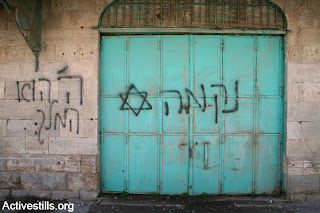By Miri
Graffiti is not a phenomenon that came up with the emergence of hip hop culture. It is definitely not a Western or a modern appearance, in fact it is a global practice that can be traced back to ancient times. If you think about it, cave paintings can be considered graffiti as well, so its history dates back to no less than 30,000 BC. Both in antique Roman, as well as in Greek culture it was not uncommon to expose one’s feelings to the public by carving a love declaration into a wall.
Back then, just like now, graffiti also constituted a way of marking territory, so its omnipresence in the contested landscapes of the Holy Land is not surprising.
 |
| Crusader Graffiti in the Church of the Holy Sepulchre, Victor Grigas |
From inscriptions in the walls of the Church of the Holy Sepulchre, that are attributed to the Crusaders and that can be seen during a Jerusalem tour, through nationalist and racist messages spray painted by radical settlers on Palestinian stores in Hebron, all the way to hopeful slogans calling for social and political change in Tel Aviv, Palestine’s and Israel’s walls speak a language of their own and testify to the complexity of the conflict on the ground.
 |
| Settler graffiti in Hebron, reading “revenge”, Keren Manor/ActiveStills |
In the Occupied Palestinian Territories the conflict between Fatah and Hamas, the biggest Palestinian parties, finds its expression on the walls of basically every village, town and city. In fact, the ubiquity of those writings on the walls may only be matched by the more recent emergence of graffiti illustrating the rivalry between the football clubs Real Madrid and FC Barcelona, that many Palestinians appropriated for themselves.
On a Nablus tour you can find names of people, who have died fighting the occupation and who are being memorised through their inscriptions on the buildings and walls close to where they were killed. Also, up until today, political movements would publish their messages on walls in an attempt to stir the masses, a notion that was particularly powerful during the First Intifada.
The most perfect canvas for graffiti, however, is unquestionably the Separation Barrier, which by now is covered in tags, images and stencils. A company, based in the Netherlands and collaborating with local Palestinians even saw a business potential in it and offered people to send them their messages, whether love declarations or messages of solidarity with the Palestinian people, via sms, which would then be spray painted on the Wall.
The most famous acts of graffiti are obviously the nine pieces that renowned
 |
| Banksy graffiti at the Wall next to Qalandiya Checkpoint |
British street artist Banksy sprayed on and glued to the Wall in 2005. “How illegal is it to vandalize a wall,” he asks in his website introduction to this project, “if the wall itself has been deemed unlawful by the International Court of Justice?“. Quite a few of Banksy’s pieces have by now been partially over painted, others were complemented by other paintings and messages, but a lot of it can still be seen during a Bethlehem tour, or on the way from Jerusalem to Ramallah. Notwithstanding the fact that Banksy’s stencils and images on the Separation Barrier are inherently political and are engaging with the nature of the Wall as imprisoning and dehumanising the Palestinian population, he also received some criticism:
Old man: You paint the wall, you make it look beautiful.
Banksy: Thanks
Old man: We don’t want it to be beautiful, we hate this wall, go home.
All of this only attests to the notion that in order to understand the different layers that constitute the Middle East conflict, one has to pay good attention to a diversity of voices, some which find their audiences only through less conventional channels.

Comment (0)